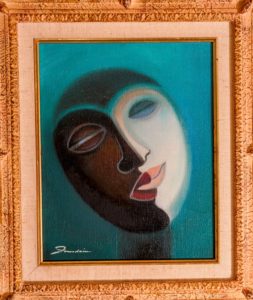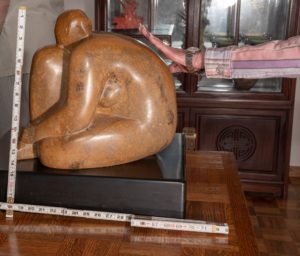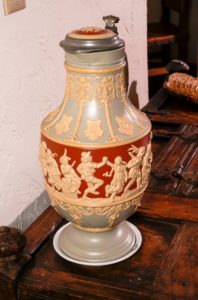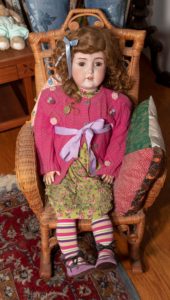 Perhaps the objects in your home speak to you in these troubled times. Maybe they say, “restore me,” “donate me,” or “think of what I mean to you.” Objects remind us of the way we were. They also remind us we are their stewards. Maybe while in lock-down you created objects, made art, crafted an object to mark this time of quarantine. All these factors now let our objects speak to us in ways differently than before.
Perhaps the objects in your home speak to you in these troubled times. Maybe they say, “restore me,” “donate me,” or “think of what I mean to you.” Objects remind us of the way we were. They also remind us we are their stewards. Maybe while in lock-down you created objects, made art, crafted an object to mark this time of quarantine. All these factors now let our objects speak to us in ways differently than before.
Some objects call out for your attention. Some long to help others by allowing themselves to become a re-gift or donation. I hear such expressions of ‘objectification’ from many of my clients retired inside the walls of their homes these past three months. The things they carry with them on this Corona-journey inspire them to take action, expand upon the ‘social responsibility’ philosophy of this unique era. At the end of this article, you will find that social responsibility has long been thought to begin at home, involving all things a home contains and signifies.
Last week the online magazine NerdWallet called me for an interview. The reporter asked where my clients donate objects in these times and asked if I wrote many appraisals for charitable contributions lately. Indeed, I have. Are we giving new life to belongings? How? Not all charities are anxious for more stuff!
I study material culture, how objects define, explain, and symbolize how we experience our present era’s culture. Each era has a different relationship with the material world, and objects bear that stamp. The pandemic caused our relationship to the “material” of our lives to change in significant ways. And we’re experiencing a double pandemic, one biological, one societal. Objects now take on a significance beyond their pre-pandemic stature.
The Artist’s Impact and the Impact upon the Artist
 I began to interview artists and performers of all stripes in March 2020, all of whom create things. On this radio series on KZSB AM 1290, called The Artist’s Impact and the Impact upon the Artist, ‘creatives’ guide us through a double pandemic of viral transmissions. I actively listen to stories of coping with the unseen transmission of a molecular disease, as well as stories of the historic transmission of the disease of racism.
I began to interview artists and performers of all stripes in March 2020, all of whom create things. On this radio series on KZSB AM 1290, called The Artist’s Impact and the Impact upon the Artist, ‘creatives’ guide us through a double pandemic of viral transmissions. I actively listen to stories of coping with the unseen transmission of a molecular disease, as well as stories of the historic transmission of the disease of racism.
For the past thirteen weeks I spoke every Friday morning on the air with remarkable playwrights, musicians, painters, poets, sculptors, actors, and dancers. Each discipline now possesses, or builds toward, a new platform. For example, a painter who created a body of work upon a theme for a gallery show has no traditional gallery in which to show today. Not only is the creative person making work, but they’re making spaces in which to show the work.
In no other discipline is this more challenging than in the dancer’s world. Dance professors from UCSB holds class from their kitchens. Dancers who perform in a company film themselves dancing in their living rooms, and patch their images into their fellow dancers’ moving images.

Painters who paint “en plein aire” now use their time outdoors in two ways: a time for solitude and focused work, or a time to witness community and mourn through the work. Artists handle creative projects in innovative, and deeply felt, ways.
My clients handle their handmade objects with more respect. I received calls asking my opinion on restoration of old family paintings and photos, queries about re-framers, bookbinders, silver-platers, questions about repair people of all kinds. Cooks handle food with more respect, too.
We also enjoy the artist with new respect:
 I bet no one has gotten through these long days without a musical playlist running in the house. We’re re-viewing favorite films, symphonies, plays, or television shows we forgot we loved. Musicians in Santa Barbara convene jazz nights, viewed online by their fans, together in real time. To come together for a performance feels bittersweet, and to view a performance alone has its own cage of emotions, through which we must “feel” the art and the artist without actually touching.
I bet no one has gotten through these long days without a musical playlist running in the house. We’re re-viewing favorite films, symphonies, plays, or television shows we forgot we loved. Musicians in Santa Barbara convene jazz nights, viewed online by their fans, together in real time. To come together for a performance feels bittersweet, and to view a performance alone has its own cage of emotions, through which we must “feel” the art and the artist without actually touching.
The creative product, whether an art product consumed in a short period of time, as in a performance, or the physical object, either handmade or mass produced, beg for our attention. From the standpoint of material cultural analysis this is because our culture asks for new solutions for a material world. This “re-start” involves our efforts to understand, as we’re called to understand, that we all belong to a larger system. We learned respect and became cautious because many factors disrupted our balance as individuals. That lack of harmony caused a ripple effect, indeed.
As in nature, so in the material world:
 To counteract unconscious negligence, our belongings ask to be rethought, repurposed, and used for good ends. This next section answers the question, “How can we use our possessions, either self-created or curated for years, to express our concern for others, as well as our concern for our planet?”
To counteract unconscious negligence, our belongings ask to be rethought, repurposed, and used for good ends. This next section answers the question, “How can we use our possessions, either self-created or curated for years, to express our concern for others, as well as our concern for our planet?”
A TIME FOR GIFTING AND DONATING
My clients enlightened me to innovative ways they donate:
CREATIVE KINDNESS – THINK SMALL
- Giving down the line: my first choice is charity thrift stores
- Section 8 housing “furnished” rooms project is a great place to give home furnishings
- Boys and Girls Clubs lounges (now more plentiful, and smaller), and they need computers, chairs, tables, even an occasional sofa
- Churches and synagogues: each place of worship knows of a family in need
- Police departments: first responders often have call for kitchen items and clothing
- Domestic violence shelters: domestic violence is on the rise due to our close quarters these days. Domestic Violence Solutions needs furniture and cooking utensils for rooms used to house abused women and children
- Soup kitchens need crockery
THINK SMALLER
- Summer camps, virtual or otherwise, need musical instruments, costumes (old clothing)
- Community mask-makers need fabric and old clothing: even those carry-bags are used to make masks
- Nursing homes need books, craft supplies (one client donated a whole china set for a mosaic project)
- Your community HOA or association may need craft materials: mine created a mural of hope on an old concrete wall from old broken china
THINK COMMUNITY AND FAMILY: GREEN CONSCIOUSNESS
- Your sister in Maine may want your winter jackets and raincoats
- Your out of work brother’s family could use that nice extra set of pots and pans
- Ask your neighbors if they know people in need of things: essential workers often need household objects.
- Start a family and friends re-use list database with photos; no one wants to go out to shop daily, but we can act as our own family “Amazon” marketplace
REINVENT WHAT YOU OWN
- Get out to your storage locker, look inside with creative eyes, and perhaps turn that old dresser into a toolbox or repurpose a shelf unit. For example I use my grandmother’s steamer to blanche fresh vegetables for freezing. I found that steamer, along with her set of aluminum 1940’s pans, in the $300 a month storage locker I should NOT have! Your mom’s kitchenware re-used is a revelation….
WHAT AND HOW TO SELL ACCORDING TO THE PRESENT MARKETPLACE
 Now, what to sell? The virus created a market for SOME works of art that don’t need handling to be purchased, OR that are inexpensive enough to enable a “risk” purchase. For that reason art under $1,000 found a new foothold selling privately. Auction houses sell prints and multiples (created in a numbered series so you know what you’re buying) for under $5,000. Signed art-photography that connects us in imagery to the greater world and other cultures is hot too.
Now, what to sell? The virus created a market for SOME works of art that don’t need handling to be purchased, OR that are inexpensive enough to enable a “risk” purchase. For that reason art under $1,000 found a new foothold selling privately. Auction houses sell prints and multiples (created in a numbered series so you know what you’re buying) for under $5,000. Signed art-photography that connects us in imagery to the greater world and other cultures is hot too.
Our home’s walls, which define our spatial existence, no doubt spoke to you these past three plus months, too, about what hangs on them. So you re-hung paintings, rearranged, re-purposed spaces beneath your roof, and you focused, no doubt, on creations, both on the walls and on the stove in the kitchen. Domestic life is NOW the space of our lives.
Goddess Hestia
 Like there’s an ‘ap’ for many things, there’s an ancient Greek Goddess for this inward pull towards the domestic. Her name is Hestia, the goddess of both the domestic and socio-political life of Greece. Homeric Hymn 29 is dedicated to Hestia, and pleads to her, “Come and dwell in this glorious house in friendship together!” The poet didn’t just talk about his actual glorious house, he talk about the house of the polis, too.
Like there’s an ‘ap’ for many things, there’s an ancient Greek Goddess for this inward pull towards the domestic. Her name is Hestia, the goddess of both the domestic and socio-political life of Greece. Homeric Hymn 29 is dedicated to Hestia, and pleads to her, “Come and dwell in this glorious house in friendship together!” The poet didn’t just talk about his actual glorious house, he talk about the house of the polis, too.
Grecians worshiped Hestia at the family hearth and at the seat of Greek executive government (the prytaneion) in a central hearth fire in the heart of the city (the agora). She imparted to the citizens, and their possessions, the right ordering of domesticity. This starts with the family, broadens into the house, both the private home and those of the executives of government, then at its broadest meaning of HOME, the state. The Homeric Hymns tell us “Hestia comes first;” hers the first offering in the family hearth, also by a larger House body.
At the center of Hestia’s symbolism, important to ancient Greece, and perhaps important for us to learn through ancient myth, is the central fire (the hearth), important for sustenance, warmth, light, and family cohesion. This image of one fire united by all other fires, from the smallest of home hearths to the largest city hearth, stresses the interconnection of social and political life. No hearth was too small to extinguish, in fact to do so by negligence was an insult to social order. To reenter order the female head of the household performed a ritual of forgiveness and relighted the hearth.
As far as the objects in the house
 Hestia holds the family keys to the cupboard, which holds what the family holds as dear: hence the term household. Hestia encourages the movement of the possessions and creations of the family into the greater community. She is an “immovable” goddess because her symbol, the hearth, has never moved. And I doubt the centrality of the images of home, heart, and hearth has moved much since we lived together as individuals in groups.
Hestia holds the family keys to the cupboard, which holds what the family holds as dear: hence the term household. Hestia encourages the movement of the possessions and creations of the family into the greater community. She is an “immovable” goddess because her symbol, the hearth, has never moved. And I doubt the centrality of the images of home, heart, and hearth has moved much since we lived together as individuals in groups.
Thus the important features of a well-ordered house expands into the community, enlarging into the greater community. This makes Hestia the goddess of the beneficent community, the well-considered society, and at the apex, thoughtful, prudent, relationship-centered respectful governance. As the First Mother, although a virgin goddess, she took care of her children. Her mother was Rhea, the Earth, after all. Her father was Kronos, the sky and time.
An important icon for our times, Hestia was the first woman of the house, responsible for the wellbeing of the family, both in microcosm, and macrocosm. It’s important to note how strong ancient patriarchal Greece considered her. Not surprising, then, that the double pandemic has drawn our kindly concern for objects and the service they render us. Our unique era gives new life to inanimate objects, because those objects, created to live with you and to be shared, are Hestia’s domain; she is not the on-stage, commanding god, she is the mutable and quietly powerful head matron of the house. And you know you can’t mess with the head mother.
Before the pandemic we never gave much thought to the hidden life of objects.
Now we need to consider those objects with thoughtfulness as we aim to share our abundance. Hestia will smile if you do!
Wonderful article, Elizabeth! You put into words so many things I have been grappling with!
Elizabeth….you are fantastic and what wonderful ways to manage, help and appreciate in today’s world! 🙂 Hope you are grand and very well. OXO, Tonia